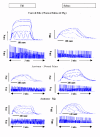Magnesium administration provokes motor unit survival, after sciatic nerve injury in neonatal rats
- PMID: 15447790
- PMCID: PMC522819
- DOI: 10.1186/1471-2474-5-33
Magnesium administration provokes motor unit survival, after sciatic nerve injury in neonatal rats
Abstract
Background: We examined the time course of the functional alterations in two types of muscles following sciatic nerve crush in neonatal rats and the neuroprotective effect of Mg2+.
Methods: The nerve crush was performed on the 2nd postnatal day. MgSO4*7H2O was administered daily for two weeks. Animals were examined for the contractile properties and for the number of motor units of extensor digitorum longus and soleus muscles at three postnatal stages and adulthood. Four experimental groups were included in this study: i) controls, ii) axotomized rats, iii) magnesium treated controls and iv) axotomized and Mg2+-treated rats.
Results: Axotomy resulted in 20% MU survival in EDL and 50% in soleus. In contrast, magnesium treatment resulted in a significant motor unit survival (40% survival in EDL and 80% in soleus). The neuroprotective effects of Mg2+ were evident immediately after the Mg2+-treatment. Immature EDL and soleus muscles were slow and fatigueable. Soleus gradually became fatigue resistant, whereas, after axotomy, soleus remained fatigueable up to adulthood. EDL gradually became fastcontracting. Tetanic contraction in axotomized EDL was just 3,3% of the control side, compared to 15,2% in Mg2+-treated adult rats. The same parameter for axotomized soleus was 12% compared to 97% in Mg2+-treated adult rats.
Conclusions: These results demonstrate that motoneuron death occurs mostly within two weeks of axotomy. Magnesium administration rescues motoneurons and increases the number of motor units surviving into adulthood. Fast and slow muscles respond differently to axotomy and to subsequent Mg2+ treatment in vivo.
Figures


Similar articles
-
Contractile properties and movement behaviour in neonatal rats with axotomy, treated with the NMDA antagonist DAP5.BMC Physiol. 2012 May 2;12:5. doi: 10.1186/1472-6793-12-5. BMC Physiol. 2012. PMID: 22551202 Free PMC article.
-
Protective effect of PNQX on motor units and muscle property after sciatic nerve crush in neonatal rats.Pharmacol Res. 2007 May;55(5):370-7. doi: 10.1016/j.phrs.2007.01.005. Epub 2007 Jan 19. Pharmacol Res. 2007. PMID: 17349799
-
Induction of transmitter release at the neuromuscular junction prevents motoneuron death after axotomy in neonatal rats.Neuroscience. 1996 Mar;71(1):213-20. doi: 10.1016/0306-4522(95)00446-7. Neuroscience. 1996. PMID: 8834403
-
Assessment of motoneuron death during development following neonatal nerve crush and Mg2+ treatment.Med Sci Monit. 2005 Oct;11(10):BR373-9. Epub 2005 Sep 26. Med Sci Monit. 2005. PMID: 16192895
-
Recovery, innervation profile, and contractile properties of reinnervating fast muscles following postnatal nerve crush and administration of L-Dopa.Brain Res Dev Brain Res. 2004 Oct 15;153(1):79-87. doi: 10.1016/j.devbrainres.2004.07.015. Brain Res Dev Brain Res. 2004. PMID: 15464220
Cited by
-
From muscle research to clinical applications: Do glutamate antagonists aid muscle recovery?Muscles Ligaments Tendons J. 2012 Sep 10;2(2):64-9. Print 2012 Apr. Muscles Ligaments Tendons J. 2012. PMID: 23738276 Free PMC article.
-
Magnesium (Mg2+): Essential Mineral for Neuronal Health: From Cellular Biochemistry to Cognitive Health and Behavior Regulation.Curr Pharm Des. 2024;30(39):3074-3107. doi: 10.2174/0113816128321466240816075041. Curr Pharm Des. 2024. PMID: 39253923 Review.
-
Applications of Biodegradable Magnesium-Based Materials in Reconstructive Oral and Maxillofacial Surgery: A Review.Molecules. 2022 Aug 28;27(17):5529. doi: 10.3390/molecules27175529. Molecules. 2022. PMID: 36080296 Free PMC article. Review.
-
Research status of biodegradable metals designed for oral and maxillofacial applications: A review.Bioact Mater. 2021 Apr 27;6(11):4186-4208. doi: 10.1016/j.bioactmat.2021.01.011. eCollection 2021 Nov. Bioact Mater. 2021. PMID: 33997502 Free PMC article. Review.
-
Sciatic nerve crush evokes a biphasic TGF-beta and decorin modulation in the rat spinal cord.Hippokratia. 2010 Jan;14(1):37-41. Hippokratia. 2010. PMID: 20411058 Free PMC article.
References
-
- Vrbova G, Gordon T, Jones R. Neve Muscle interaction. 2. Chapman and Hall; 1995.
MeSH terms
Substances
LinkOut - more resources
Full Text Sources
Research Materials

